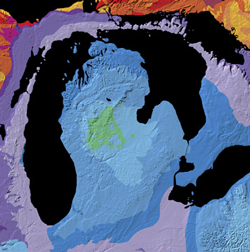
The Turkey Vulture, Cathartes aura, also known in North America as the Turkey Buzzard (or just "buzzard"), is a bird found throughout most of the Americas. One of three species in the genus Cathartes, in the family Cathartidae, it is the most widespread of the New World vultures,[2] ranging from southern Canada to the southernmost tip of South America. It inhabits a variety of open and semi-open areas, including subtropical forests, shrublands, pastures, and deserts. With a wingspan of 173–183 cm (68–72 in) and an average weight of 1.4 kg (3.1 lb), the Turkey Vulture is a large bird. It has dark brown to black plumage; a featherless, purplish-red head and neck; and a short, hooked, ivory-colored beak.
The Turkey Vulture is a scavenger and feeds almost exclusively on carrion. It finds its meals using its sense of smell, flying low enough to detect the gases produced by the beginnings of the process of decay in dead animals. In flight, it uses thermals to move through the air, flapping its wings infrequently. It roosts in large community groups. Lacking a syrinx—the vocal organ of birds—its only vocalizations are grunts or low hisses. It nests in caves, hollow trees, or thickets, each year generally raising two chicks, which it feeds by regurgitation. It has very few natural predators. In the United States of America, the vulture receives legal protection under the Migratory Bird Treaty Act of 1918.
The Turkey Vulture forages by smell, an ability that is uncommon in the avian world. It often will fly low to the ground to pick up the scent of ethyl mercaptan, a gas produced by the beginnings of decay in dead animals. The olfactory lobe of its brain, responsible for processing smells, is particularly large compared to that of other animals. This heightened ability to detect odors allows it to search for carrion below the forest canopy.
Why the Turkey Vulture Vomits
The turkey vulture has few natural predators. Its primary form of defense is vomiting. The birds do not "projectile vomit," as many would claim. They simply cough up a lump of semi-digested meat. This foul smelling substance deters most creatures intent on raiding a vulture nest. It will also sting if the offending animal is close enough to get the vomit in its face or eyes.
Vulture facts :
A group of vultures is called a "venue."
Vultures circling in the air are called a "kettle."
The turkey vulture is one of the most skilled gliders among the North American birds. It migrates across the continents with minimal energy output. Vultures launch themselves from their perches only after the morning air has warmed. Then, they circle upward, searching for pockets of rising warm air, or thermals. Once they have secured a thermal, they allow it to carry them upward in rising circles. When they reach the top of the thermal, they dive across the sky at speeds near 60 miles per hour, losing altitude until they reach another thermal. All this is done without the necessity to flap. In fact, the turkey vulture can glide for over 6 hours at a time without flapping a wing !








No comments:
Post a Comment